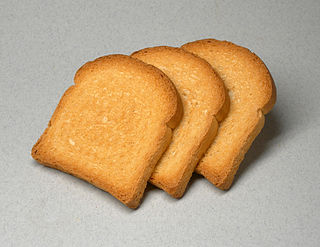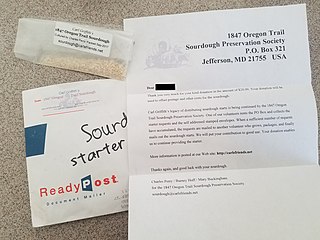Related Research Articles

Yeasts are eukaryotic, single-celled microorganisms classified as members of the fungus kingdom. The first yeast originated hundreds of millions of years ago, and at least 1,500 species are currently recognized. They are estimated to constitute 1% of all described fungal species.

Bread is a staple food prepared from a dough of flour and water, usually by baking. Throughout recorded history and around the world, it has been an important part of many cultures' diet. It is one of the oldest human-made foods, having been of significance since the dawn of agriculture, and plays an essential role in both religious rituals and secular culture.

Amish friendship bread is a type of bread or cake made from a sourdough starter that is often shared in a manner similar to a chain letter. The starter is a substitute for baking yeast and can be used to make many kinds of yeast-based breads, shared with friends, or frozen for future use. The sweet, cake-like Amish cinnamon bread is a common bread that is made from this starter; it is a simple, stirred quickbread that includes a substantial amount of sugar and vegetable oil, with a mild cinnamon flavor. It has characteristics of both pound cake and coffee cake. The flavor of the finished product can be altered by cinnamon being omitted.

Sourdough is a bread made by the fermentation of dough using wild lactobacillaceae and yeast. Lactic acid from fermentation imparts a sour taste and improves keeping qualities.

Baker's yeast is the common name for the strains of yeast commonly used in baking bread and other bakery products, serving as a leavening agent which causes the bread to rise by converting the fermentable sugars present in the dough into carbon dioxide and ethanol. Baker's yeast is of the species Saccharomyces cerevisiae, and is the same species as the kind commonly used in alcoholic fermentation, which is called brewer's yeast. Baker's yeast is also a single-cell microorganism found on and around the human body.

A bagel is a bread product originating in the Jewish communities of Poland. It is traditionally shaped by hand into the form of a ring from yeasted wheat dough, roughly hand-sized, that is first boiled for a short time in water and then baked. The result is a dense, chewy, doughy interior with a browned and sometimes crisp exterior. Bagels are often topped with seeds baked on the outer crust, with the traditional ones being poppy and sesame seeds. Some may have salt sprinkled on their surface, and there are different dough types, such as whole-grain and rye.

Pumpernickel is a typically heavy, slightly sweet rye bread traditionally made with sourdough starter and coarsely ground rye. It is sometimes made with a combination of rye flour and whole rye grains.

A rusk is a hard, dry biscuit or a twice-baked bread. It is sometimes used as a teether for babies. In some cultures, rusk is made of cake, rather than bread: this is sometimes referred to as cake rusk. In the UK, the name also refers to a wheat-based food additive.

A bread making machine or breadmaker is a home appliance for turning raw ingredients into baked bread. It consists of a bread pan, at the bottom of which are one or more built-in paddles, mounted in the center of a small special-purpose oven. This small oven is usually controlled by a simple built-in computer using settings input via a control panel. Most bread machines have different cycles for different kinds of dough—including white bread, whole grain, European-style, and dough-only. Many also have a timer to allow the bread machine to activate without operator attendance, and some high-end models allow the user to program a custom cycle.
Boudin Bakery is a bakery based in San Francisco, California, known for its sourdough bread. The bakery is recognized as the "oldest continually operating business in San Francisco." It was established in 1849 by Isidore Boudin, son of a family of master bakers from Burgundy, France, by blending the sourdough prevalent among miners in the Gold Rush with French techniques.

Biga is a type of pre-fermentation used in Italian baking. Many popular Italian breads, including ciabatta, are made using a biga. Using a biga adds complexity to the bread's flavor and is often used in breads that need a light, open texture with holes. Apart from adding to flavor and texture, a biga also helps to preserve bread by making it less perishable.

Rye bread is a type of bread made with various proportions of flour from rye grain. It can be light or dark in color, depending on the type of flour used and the addition of coloring agents, and is typically denser than bread made from wheat flour. Compared to white bread, it is higher in fiber, darker in color, and stronger in flavor.
A ferment is a fermentation starter used in indirect methods of bread making. It may also be called mother dough.

In cooking, proofing is a step in the preparation of yeast bread and other baked goods in which the dough is allowed to rest and rise a final time before baking. During this rest period, yeast ferments the dough and produces gases, thereby leavening the dough.

The Acme Bread Company is a Berkeley, California-based bakery that is one of the pioneers of the San Francisco Bay Area's "Bread Revolution," which in turn created the modern "artisan bread" movement in America, and remains a "benchmark" for commercial handmade bread.
The history of California bread as a prominent factor in the field of bread baking dates from the days of the California Gold Rush around 1849, encompassing the development of sourdough bread in San Francisco. It includes the rise of artisan bakeries in the 1980s, which strongly influenced what has been called the "Bread Revolution".
Limosilactobacillus pontis is a rod-shaped, Gram-positive facultatively anaerobic bacterium. Along with other Lactobacillus species, it is capable of converting sugars, such as lactose, into lactic acid. Limosilactobacillus pontis is classified under the phylum Bacillota, class Bacilli, and is a member of the family Lactobacillaceae and is found to be responsible for the fermentation of sourdough, along with many other Lactobacillus species. This microorganism produces lactic acid during the process of fermentation, which gives sourdough bread its characteristic sour taste.

Carl Griffith's sourdough starter, also known as the Oregon Trail Sourdough or Carl's starter, is a sourdough culture, a colony of wild yeast and bacteria cultivated in a mixture of flour and water for use as leavening. Carl's starter has a long history, dating back at least to 1847, when it was carried along the Oregon Trail by settlers from Missouri to Oregon. It was then passed down as an heirloom within the family of Carl Griffith, who shared it via Usenet in the 1990s. Since the year 2000, it has been maintained and shared by a dedicated historical preservation society; its volunteers keep the starter alive, feeding the organisms flour and water, and mail free samples worldwide on request for use by bakers in seeding their own cultures.
References
- ↑ "Inside the World's Only Sourdough Library". Atlas Obscura. 2018-05-16. Archived from the original on 2018-07-09. Retrieved 2018-07-09.
- ↑ "Puratos Canada inducts Canada's first sourdough culture into its one-of-a-kind sourdough library". www.newswire.ca. Archived from the original on 2018-07-09. Retrieved 2018-07-09.
- ↑ "Center for Bread Flavour". Archived from the original on 2018-10-23. Retrieved 2018-10-23.
- ↑ MEDIA, CNS. "Puratos Opens World's First Sourdough Library". foodingredientsfirst.com/. Archived from the original on 2018-07-09. Retrieved 2018-07-09.
- ↑ "Puratos sourdough library inducts first Canadian sourdough | bake | baking news". Archived from the original on 2018-07-09. Retrieved 2018-07-09.
- ↑ "The Puratos World Heritage Sourdough Library | The Quest for Sourdough". Quest for sourdough. Archived from the original on 2018-07-09. Retrieved 2018-07-09.
- ↑ "Puratos nearly doubles its sourdough library". Archived from the original on 2021-10-26. Retrieved 2018-07-09.